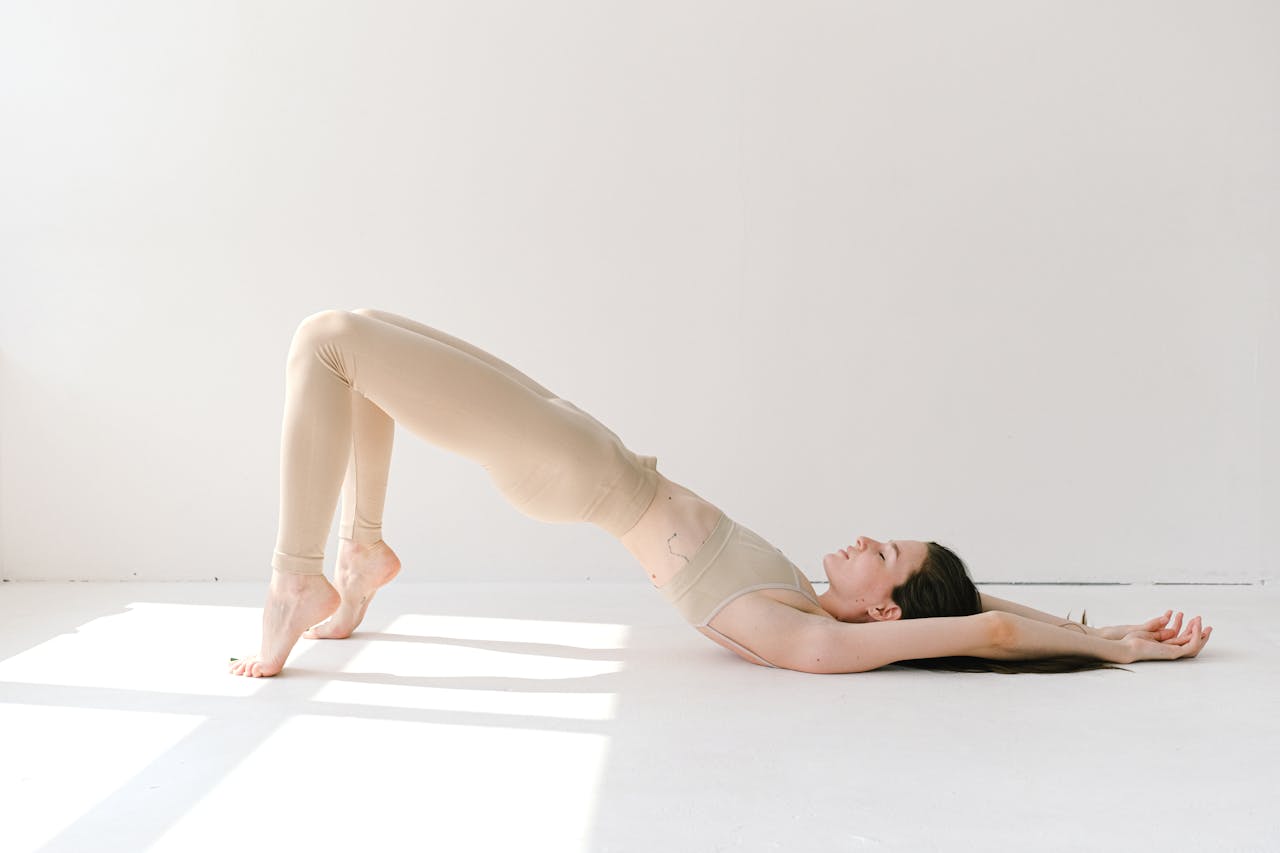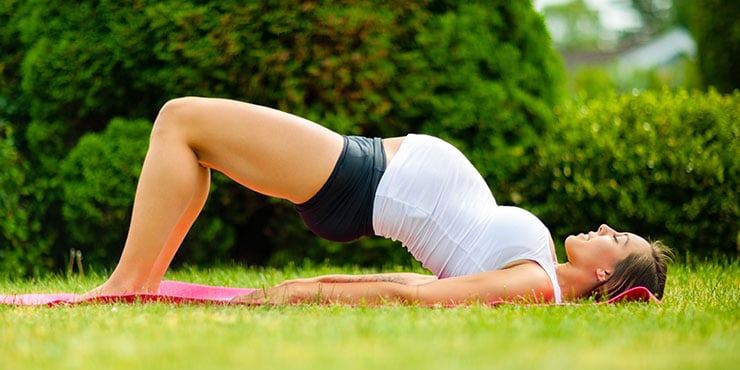
Table of Contents
Setu Bandhasana, also known as bridge pose, is a yoga asana that involves lifting the hips while lying on the back, creating a "bridge" shape with the body. It can help stretch the chest, neck, and spine while also strengthening the glutes, hamstrings, and core muscles. It's a beginner-friendly pose with many modifications to suit different levels of flexibility and mobility.
Setu Bandhasana - An Inverted Backbend Yoga Pose
Setu Bandhasana is an inverted back bending asana that involves lying on one's back with their feet flat on the floor and bent knees hip-width apart. The practitioner then lifts their hips using their legs and bends their spine backward. To enhance the pose, the practitioner may clasp their hands behind their back, grab their feet, or place them beside their body. Retracting the shoulder blades and bringing them together can help to lift the upper back off the floor, making the pose more effective.
The Sanskrit Translation of Setu Bandhasana
Bridge pose gets its name from Sanskrit words, with "Setu" meaning bridge and "Bandha" meaning lock or bound. The term "asana" in Sanskrit means posture. This yoga pose is also called Setu Bandha Sarvangasana, where "Sarvangasana" is another name for the shoulder stand, highlighting the use of the shoulders as support while performing the pose.
Setu Bandhasana Benefits
Practicing bridge pose has many benefits for practitioners, including:
-
Strengthens the upper body: This yoga pose trains and strengthens the spinal erectors, gluteus maximus, muscles along the outer thighs, and quadriceps. Bridge pose stretches the front of the hips, waist, ribcage, and shoulders.
-
Supports stability: Bridge pose helps solidify one’s center of gravity and strengthen their core for greater everyday balance.
-
Improves posture: The pose may also help improve chest posture, counteract excessive sitting, and calm the mind.
-
Aids flexibility: This posture stretches the hip flexors, back, and lower body, helping make the spine flexible.
-
Alleviates stress and mild depression: Bridge pose supports blood circulation and oxygen supply to the brain and nervous system to calm the mind.
Additionally, this yoga posture opens the lungs, improves the functioning of the thyroid glands, and improves digestion by stimulating the abdominal organs. Bridge pose also relieves the symptoms of menopause and menstrual pain. Frequent practice of this posture has the potential to help with asthma, osteoporosis, and sinusitis.
Backbending yoga poses such as Setu Bandhasana should be on a practitioner's yoga-to-do list if one has a job that requires them to sit for long hours. It will not just alleviate back pain but also improve one's overall health.
Bridge Pose Chakra Associations
Setu Bandhasana is commonly associated with the Vishuddha (throat) chakra, which can help open and activate this energy center. This activation comes from lifting the chest and throat, which can help release tension and blockages in this area. Additionally, the Vishuddha chakra is associated with self-expression, communication, and creativity, and practicing Setu Bandhasana can help promote these qualities by stimulating and balancing the throat chakra.
Contraindications for Setu Bandhasana
While Setu Bandhasana has numerous benefits, it is not for everyone. Practitioners with any of the following conditions should completely avoid this posture:
- Ankle injuries or sprains
- Neck or shoulder injuries or sprains
- Recent spinal, shoulder, hip, knee surgeries
- High blood pressure
- Heart patients
- Abdominal herniations
If practitioners have a medical condition that puts them at risk, they should speak to a doctor and yoga expert before performing bridge pose or starting any yoga session.
Setu Bandhasana Preparatory Poses
Preparatory Poses for Engaging the Back Muscles
To develop an understanding of back muscle engagement, individuals can practice locust pose (Shalabhasana) before attempting bridge pose. The practitioner begins by lying face down with a lengthened spine. Slowly lifting their head and looking forward while feeling the muscles at the back of their neck activate, they then bend backward and lift their chest without using their arms. They focus on the sensation along their spine as their spinal erectors activate and note how the back bend intensifies the feeling.
Next, the individual can practice the same action while sitting upright in a chair. They tilt their pelvis forward to initiate the back bend, moving their pubic bone down and their sacrum up. Keeping their ribs reasonably upright, they feel their lumbar spine bend backward, carrying the back bend up their ribcage, one vertebra at a time.
To enhance the sensation of back muscle activation, individuals can activate their abdominal muscles to resist their rib cage from lifting. This increases the force against which their back muscles can work, making it easier to feel their activation. It also helps them lift their chest against the resistance of their abdominal muscles.
If individuals do not have access to a chair or prefer not to use one, they can also practice this spinal back bend while in hero pose or kneeling with their hips on their heels.
Preparatory Exercises for Arms and Shoulders
To perform Setu Bandhasana effectively, one can clasp their hands behind their back, grab their ankles, or place their hands beside them. Retracting the shoulders is essential to enhance the pose, as it involves drawing each shoulder blade towards the spine. To maintain balance, practitioners should also practice protracting their shoulders by spreading them forward.
By retracting the shoulders while performing Bridge Pose, the back of the upper thoracic spine is lifted off the floor, which reduces pressure in that area. To further engage the arms and shoulders, practitioners can pull their hands apart while clasping them behind their back.
This movement strengthens the upper arms and provides a better understanding of the pose.
If grabbing the ankles, practitioners can stiffen their feet and actively use their arm muscles to pull on them. This action increases the chest's lifting and opening and encourages the scapulae's inward movement.
Scapular Retraction Practice
One can improve their understanding of scapular retraction by practicing it while sitting or standing upright. To do this, practitioners should move their shoulders back and feel the inner edges of each shoulder blade move inward. While actively drawing the shoulder blades inward, one should observe a sensation of muscular activation between them. Repeat this exercise a few times before relaxing.
To further practice scapular retraction, practitioners can clasp their hands behind their backs with straight elbows while sitting or standing. For those unable to clasp their hands, grab hold of a towel instead. While pulling outward on their hands or the towel, practitioners should actively draw their shoulders inward and lift their chest. Repeat this exercise a few times, focusing on performing both actions slowly and smoothly.
Setu Bandhasana Preparatory Pose
To prepare for Bridge Pose, practitioners can lie on their backs with their knees bent and feet flat on the floor, hip-distance apart. They should ensure their feet are positioned on the floor hip-width apart. In this position, practitioners can tilt their pelvis forward, causing their spine to bend backward. This movement allows for practicing spinal back bending in a horizontal position rather than vertical.
The cobra pose, also known as Bhujangasana, is a gentle backbend that warms up the back muscles. To execute this pose, one must lie face down on a mat, placing their hands beneath their shoulders. Inhale and push into the hands, raising their head and chest off the ground while maintaining relaxed shoulders and keeping their elbows close to their body.
Setue Bandhasana Follow Up Poses
While learning this posture, follow-up poses like the wind relieving pose, also known as Pawanmuktasana, can relieve the lower back, hip, and leg muscles. Begin lying on the back with the legs extended. Bring one knee towards their chest, clasping their hands around it, and hold the pose for a few breaths before releasing and repeating on the other side. This pose can help relieve bloating and gas in the abdomen and can also help stretch the lower back muscles.
How to Perform Setu Bandhasana
 New yoga practitioners should practice this pose on a cushioned surface or yoga mat. If possible, practice it in the morning and on an empty stomach.
New yoga practitioners should practice this pose on a cushioned surface or yoga mat. If possible, practice it in the morning and on an empty stomach.
Here are the simple steps to perform bridge pose:
-
Begin by lying on the back with their knees bent and their heels touching their hands.
-
With the arms alongside the body and palms down, press down with their feet to lift their hips.
-
Before lifting, practitioners should engage their feet and ankles by stiffening them and pressing them down with their heels and forefeet. Take a deep breath and slowly lift the pelvis and torso off the ground.
-
Experiment with turning the feet in and out to ensure that they are parallel, and move the knees in and out to find a comfortable position where the knees are hip-width apart. Adjust the position of their knees slightly inward or outward for comfort, evenly distributing the body weight pressing into the feet.
-
Practitioners can rotate their shins slightly inward or outward to vary the arch lift and position of their knees. While making these adjustments, it is essential to keep the feet active to ensure knee comfort.
-
Maintain deep breathing and lower after ] five to ten deep breaths.
-
Repeat as necessary.
Correcting the Alignment in Bridge Pose
When performing Setu Bandhasana (Bridge Pose), some people may experience their feet turning out. To avoid this, practice aligning the feet while lying on the back with bent knees. Alternately turn the feet in and out to become familiar with parallel placement. Keep the feet parallel and hip-width apart on the floor when performing the actual pose.
Control The Pelvis
When performing Bridge Pose, it is important to tilt the pelvic floor forward by dropping the pubic bone and engaging the spinal erectors to bend the spine backward actively. Begin at the tailbone and sacrum and move upwards to the top of the back of the ribcage. Maintaining this focus throughout the pose will ensure more effective practice.
Engage The Glutes
Once the pelvis is tilted forward and the spinal erectors are active, the practitioner should engage the glutes to lift the hips higher in the bridge pose. As the hips move up, they should shuffle their shoulders forward to deepen the backbend in the lumbar and thoracic spine. It's essential to keep the knees hip-width apart and use the glutes to maintain this position. The practitioner can press down on their inner thighs or upwards for additional support.
Neck engagement
To enhance neck engagement in Setu Bandhasana, one can activate the muscles in front of the neck to lift the chest closer to the chin. Another option is to engage the muscles at the back of the neck to resist the stretch and make the back of the neck feel longer. This neck bend is similar to the one in a shoulder stand but with a less intense stretch.
Strengthening the Legs and Spine
Straightforward yoga asanas like bridge pose strengthen weak and tired legs. As an inversion, the pose places the hips higher than the head. Practitioners can engage their legs to lift their hips and bend their spine backward, creating the bridge-like shape of the pose. This yoga pose has the potential to relieve the lower back and hip joints for greater mobility.
Incorporating Arms in Bridge Pose
After mastering the basic elements of bridge pose, one can incorporate their arms. This can be done by positioning the hands flat on the floor beside the body and actively pressing down to retract the scapulae. Alternatively, one can bend the elbows and point the forearms up with fingers spread, digging the elbows into the floor to lift and open the chest towards the chin. Another option is to clasp the hands behind the back or grab onto the ankles with palms facing inward. The arms can pull on the ankles while the leg muscles resist the pull.
References
Bridge Pose | Setu Bandhasana | The Art of Living India
Bridge Pose (Setu Bandhasana) Contraindications | Tummee.com
Bridge Pose: How to Practice Setu Bandha Sarvangasana
Disclaimer
The contents of this article are provided for informational purposes only and are not intended to substitute for professional medical advice, diagnosis, or treatment. It is always recommended to consult with a qualified healthcare provider before making any health-related changes or if you have any questions or concerns about your health. Anahana is not liable for any errors, omissions, or consequences that may occur from using the information provided.

By: Anahana
The Anahana team of researchers, writers, topic experts, and computer scientists come together worldwide to create educational and practical wellbeing articles, courses, and technology. Experienced professionals in mental and physical health, meditation, yoga, pilates, and many other fields collaborate to make complex topics easy to understand.
